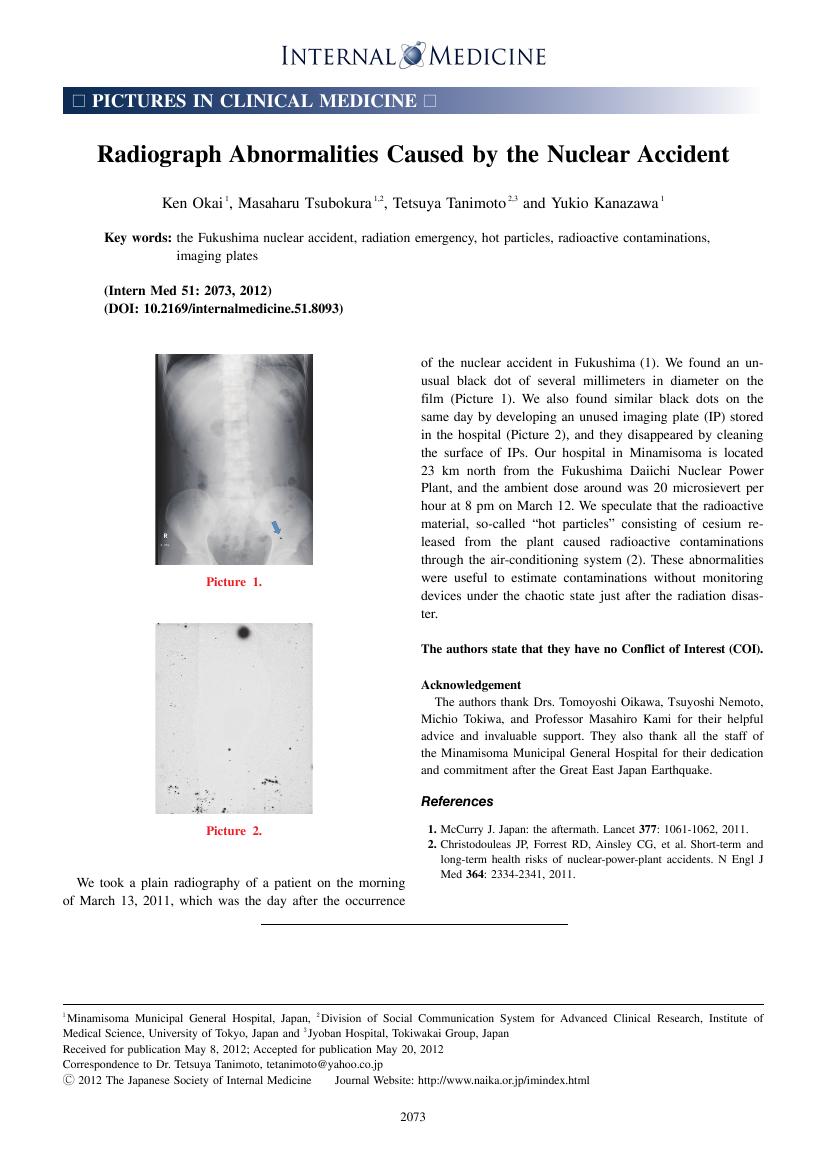- 著者
- Ryugo S. HAYANO Masaharu TSUBOKURA Makoto MIYAZAKI Akihiko OZAKI Yuki SHIMADA Toshiyuki KAMBE Tsuyoshi NEMOTO Tomoyoshi OIKAWA Yukio KANAZAWA Masahiko NIHEI Yu SAKUMA Hiroaki SHIMMURA Junichi AKIYAMA Michio TOKIWA
- 出版者
- The Japan Academy
- 雑誌
- Proceedings of the Japan Academy, Series B (ISSN:03862208)
- 巻号頁・発行日
- vol.91, no.8, pp.440-446, 2015-10-09 (Released:2015-10-09)
- 参考文献数
- 14
- 被引用文献数
- 18 28
BABYSCAN, a whole-body counter (WBC) for small children was developed in 2013, and units have been installed at three hospitals in Fukushima Prefecture. Between December, 2013 and March, 2015, 2707 children between the ages of 0 and 11 have been scanned, and none had detectable levels of radioactive cesium. The minimum detectable activities (MDAs) for 137Cs were ≤3.5 Bq kg−1 for ages 0–1, decreasing to ≤2 Bq kg−1 for ages 10–11. Including the 134Cs contribution, these translate to a maximum committed effective dose of ∼16 µSv y−1 even for newborn babies, and therefore the internal exposure risks can be considered negligibly small.Analysis of the questionnaire filled out by the parents of the scanned children regarding their families’ food and water consumption revealed that the majority of children residing in the town of Miharu regularly consume local or home-grown rice and vegetables, while in Minamisoma, a majority avoid tap water and produce from Fukushima. The data show, however, no correlation between consumption of locally produced food and water and the children’s body burdens.
- 著者
- Ken Okai Masaharu Tsubokura Tetsuya Tanimoto Yukio Kanazawa
- 出版者
- 一般社団法人 日本内科学会
- 雑誌
- Internal Medicine (ISSN:09182918)
- 巻号頁・発行日
- vol.51, no.15, pp.2073-2073, 2012 (Released:2012-08-01)
- 参考文献数
- 2
- 被引用文献数
- 1
- 著者
- Toyoaki Sawano Masaharu Tsubokura Claire Leppold Akihiko Ozaki Sho Fujioka Tsuyoshi Nemoto Shigeaki Kato Tomoyoshi Oikawa Yukio Kanazawa
- 出版者
- (公社)日本産業衛生学会
- 雑誌
- Journal of Occupational Health (ISSN:13419145)
- 巻号頁・発行日
- vol.58, no.3, pp.320-322, 2016-05-20 (Released:2016-06-16)
- 参考文献数
- 20
- 被引用文献数
- 12
Objectives: Patients with underlying conditions are at a higher risk of developing sepsis, a systematic response to infection, which has a high mortality rate. After the March 2011 Fukushima Daiichi nuclear power plant accident, there has been an influx of migrant decontamination workers; however, little is known about their health status.Case: A Japanese 55-year-old male decontamination worker, who had several underlying diseases, was transferred to our hospital in cardiopulmonary arrest. He had a history of diabetes mellitus and hypertension and a past history of tuberculosis. Control of underlying conditions was poor, with HbA1c of 13.8% at presentation. He was diagnosed with pneumonia-induced bacteremia and sepsis due to Klebsiella pneumoniae. Although spontaneous circulation returned in emergency room, he died a day after admission.Conclusion: The poor control of underlying diseases seen in this patient could have been influenced by his recent job transfer and engagement in decontamination work and additionally related to his socioeconomic status (SES). This case highlights the need for further research to elucidate the underlying diseases, working conditions, and SES of this population.
- 著者
- Toyoaki Sawano Masaharu Tsubokura Claire Leppold Akihiko Ozaki Sho Fujioka Tsuyoshi Nemoto Shigeaki Kato Tomoyoshi Oikawa Yukio Kanazawa
- 出版者
- (公社)日本産業衛生学会
- 雑誌
- Journal of Occupational Health (ISSN:13419145)
- 巻号頁・発行日
- pp.15-0292-CS, (Released:2016-04-22)
- 被引用文献数
- 12
Objectives: Patients with underlying conditions are at a higher risk of developing sepsis, a systematic response to infection, which has a high mortality rate. After the March 2011 Fukushima Daiichi nuclear power plant accident, there has been an influx of migrant decontamination workers; however, little is known about their health status. Case: A Japanese 55-year-old male decontamination worker, who had several underlying diseases, was transferred to our hospital in cardiopulmonary arrest. He had a history of diabetes mellitus and hypertension and a past history of tuberculosis. Control of underlying conditions was poor, with HbA1c of 13.8% at presentation. He was diagnosed with pneumonia-induced bacteremia and sepsis due to Klebsiella pneumoniae. Although spontaneous circulation returned in emergency room, he died a day after admission. Conclusion: The poor control of underlying diseases seen in this patient could have been influenced by his recent job transfer and engagement in decontamination work and additionally related to his socioeconomic status (SES). This case highlights the need for further research to elucidate the underlying diseases, working conditions, and SES of this population.
